Dreaming of seeing the Iberian lynx? With a bit of effort, you can spend days watching these stunning felids in Sierra de Andujar Natural Park in southern Spain. I’ll tell you how.
After a 2-year-long COVID-induced hiatus, I finally had an opportunity to venture out in search of wild cats again. Only this time, I travelled as a PhD researcher rather than a carefree tourist. However, I did make sure to schedule my fieldwork around my birthday since Spain is the only destination where you can combine a birthday in Europe with a wild cat trip.
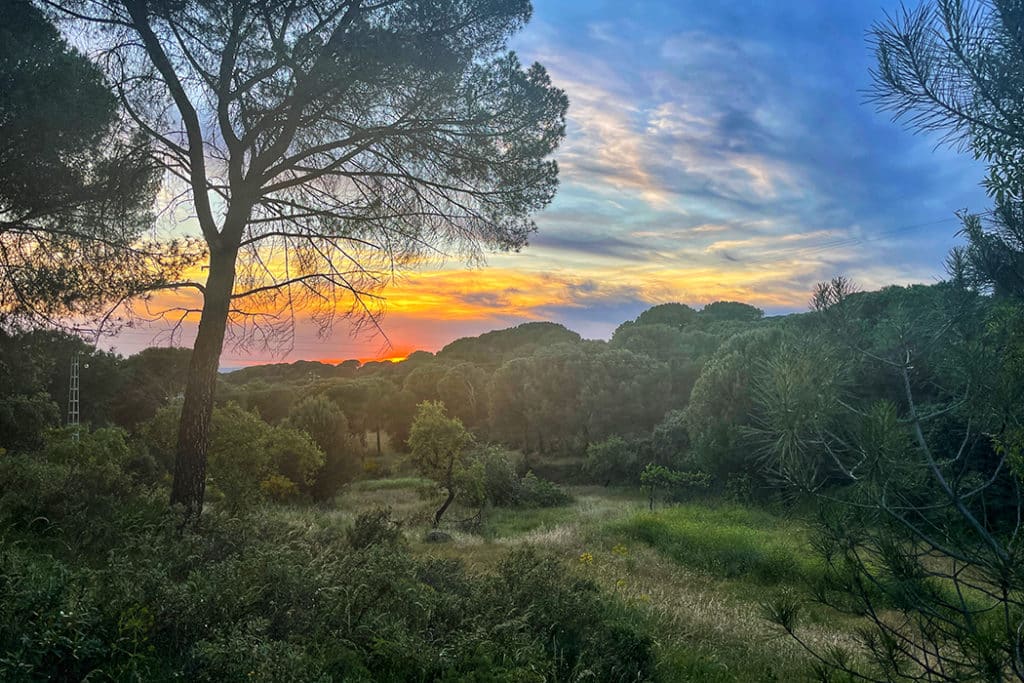
As part of my research on how people and wild cats are learning to live together in the changing world, I travelled to the south of Spain and spent three weeks in the Andalusian countryside on the fringes of Sierra de Andujar Natural Park, about halfway between Valencia and Cadiz.
This park, composed almost entirely of private hunting estates, is the best place in the world to see the Iberian lynx, a stunning felid we almost lost at the turn of the century.
Iberian lynx in Sierra de Andujar
While the number of lynxes in the park has been steadily decreasing over the past decade, Sierra de Andujar Natural Park remains one of the best places in Spain to observe the Iberian lynx.
And this is the beauty of Sierra de Andujar – you don’t just spot the lynx for a few fleeting moments; you can watch their lives unfold right in front of you. All because two females established their breeding territories in areas easily accessible by human observers.
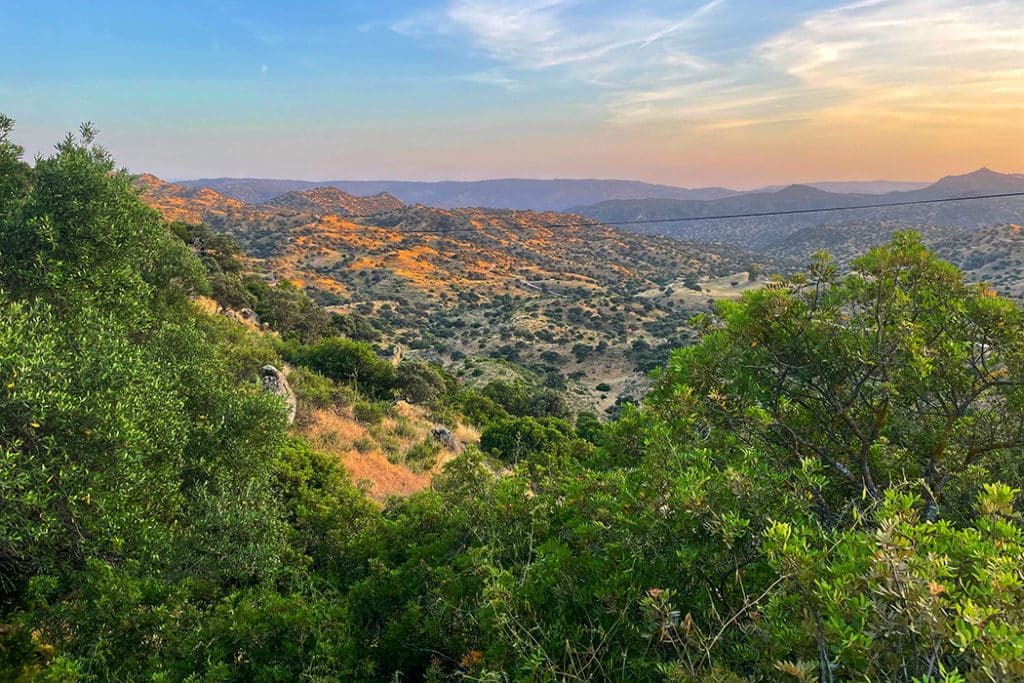
Over my three weeks in the park, I watched one of these females – Magarza, raise her litter of 3 cubs. Only once the family disappeared for 2 days, after an unseasonably hot day. Every other day, you could watch Magarza and her cubs in the morning and in the afternoon. The middle of the day in Andalusia, even in late spring, is uncomfortably hot.
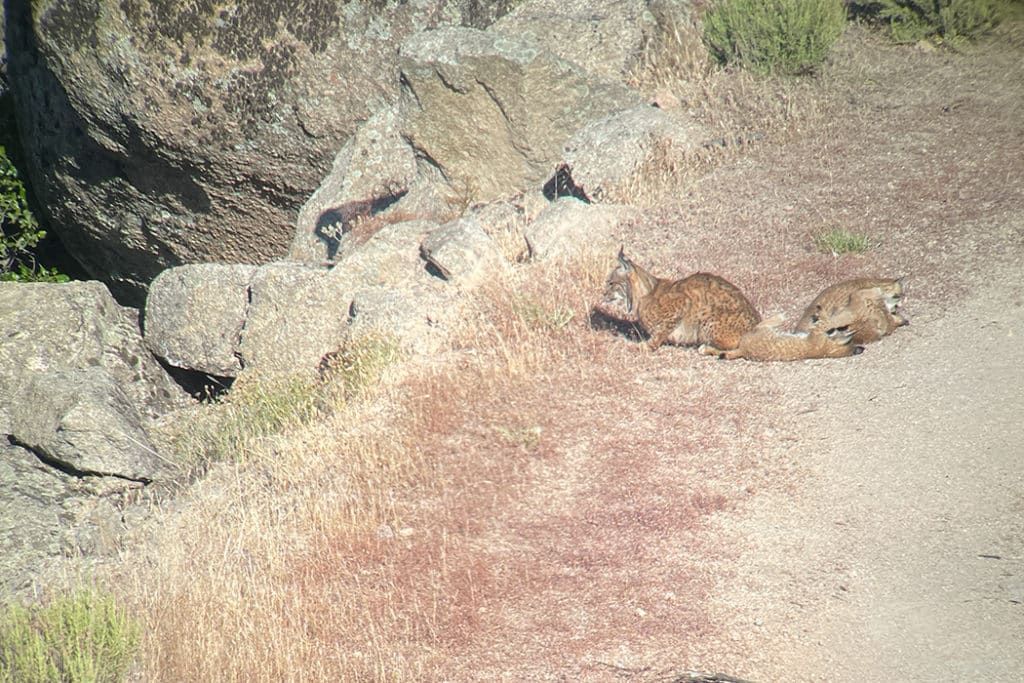
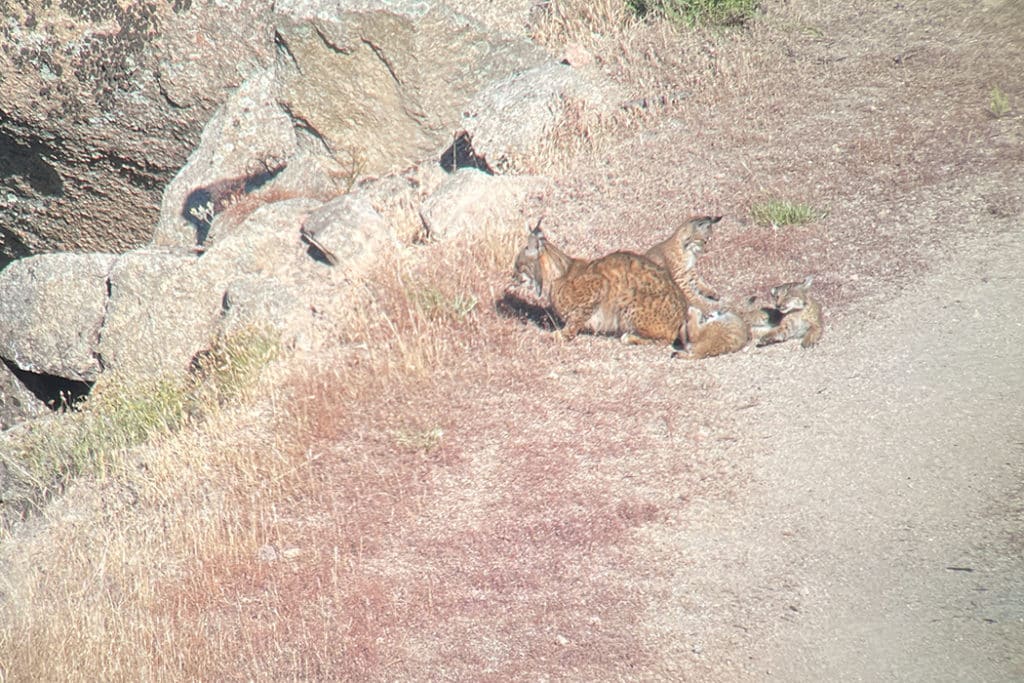
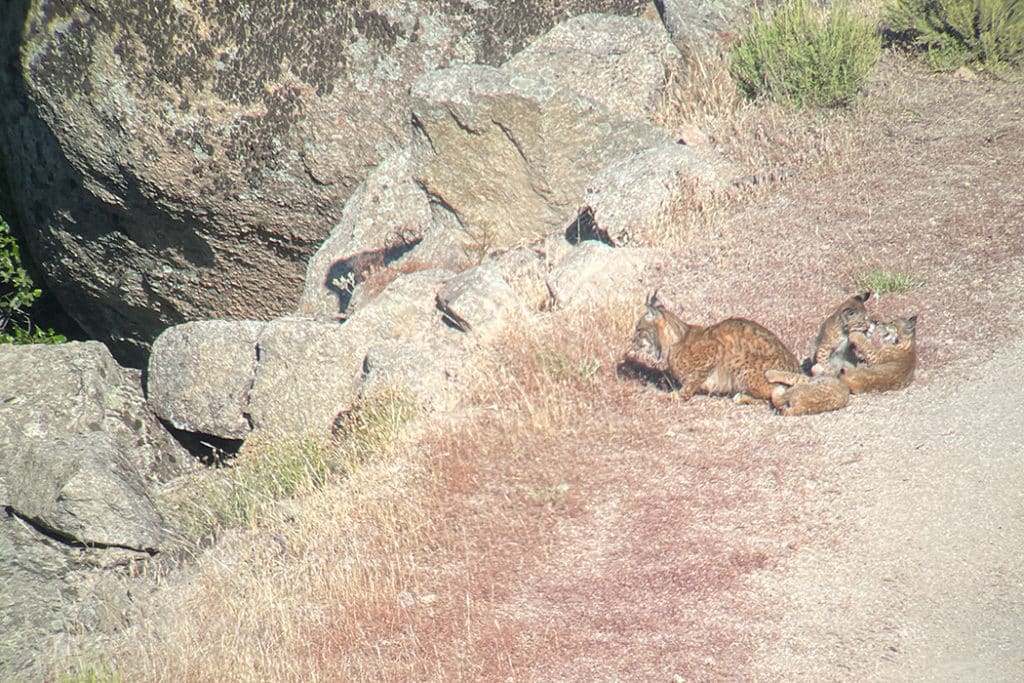
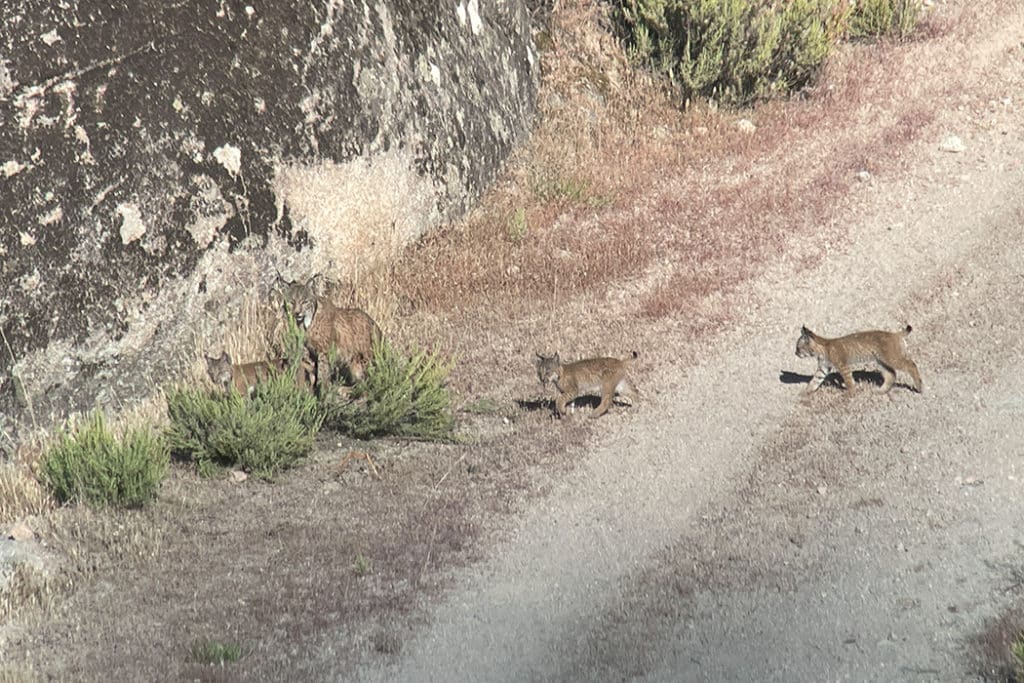
Occasionally we also spotted Magarza’s grown-up cubs from previous years, sometimes at a very close range.
On my first day in the park, we had a very close encounter with Rafiki – Magarza’s son from the 2019 litter. He is almost fully grown and should be venturing out in search of his own territory, but for now, Magarza lets him stick around.
That morning, he crossed the road through a runoff drain and emerged right in front of us in a field of yellow and purple flowers.
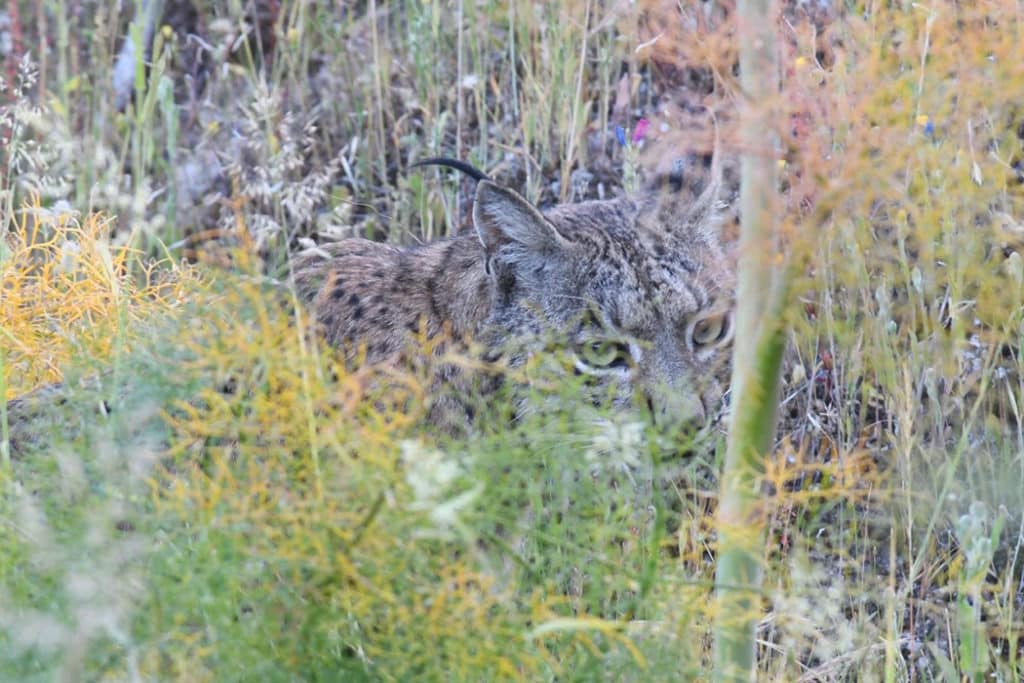
The proximity of such encounters always fills me with awe. When you get to look into the cat’s alert predatory eyes and watch it move with that impossible feline grace and precision.
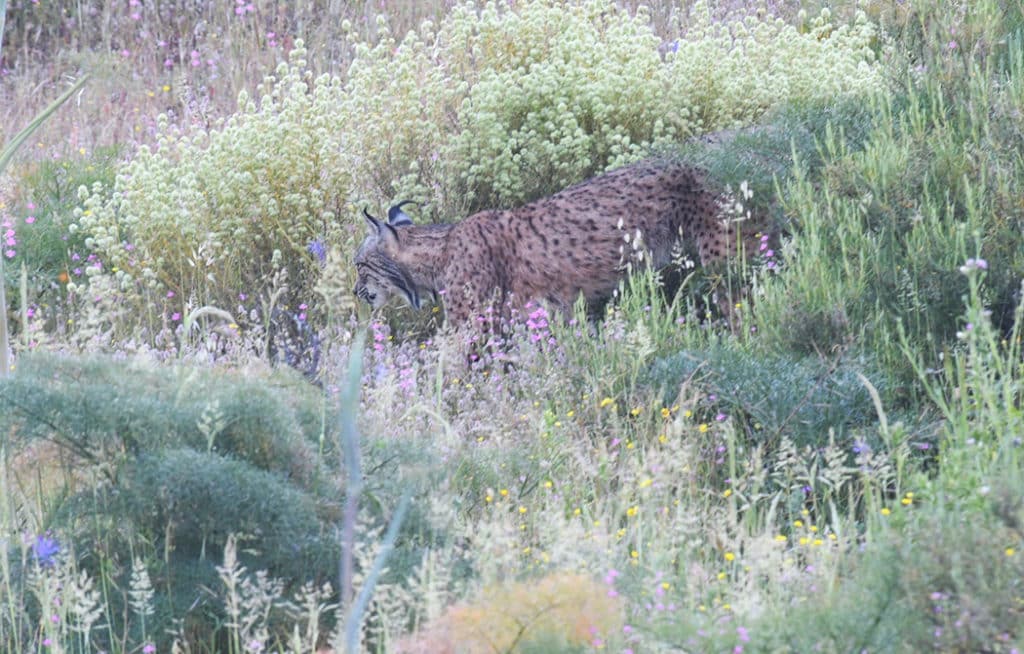
Magarza was never this close. She kept her family on the opposite side of the valley from La Lancha dirt road that doubles up as the lynx-watching stakeout (more details on the location at the end of the post). She moved her cubs to new dens up and down the slope over the weeks and, for the last week, stayed at the bottom of the valley, about 250 meters away from us – the closest she’s ever been.
We would watch her leave the cubs alone every morning (she may have left them alone at night, too) and go off to hunt. Iberian Lynx is a rabbit specialist, and rabbits have been getting very scarce in Sierra de Andujar.
The cubs would while away the time endlessly chasing each other, running single file up and down the sun-baked dirt road on the bottom of the valley. Their naive curiosity saw them tumbling down from the rocks, skidding off the road into the bushes, and completely failing any stalking attempts.
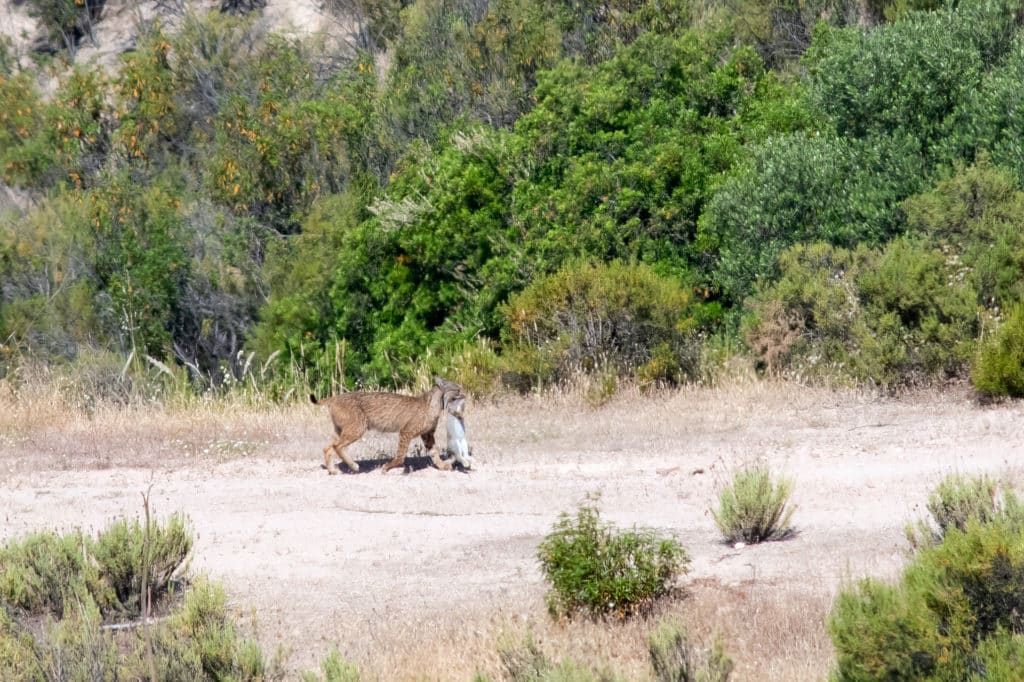
After a couple of hours, Magarza would return either with a rabbit in her mouth or with nothing to show for her efforts. If her morning hunt was unsuccessful, she stayed with the cubs long enough to nurse them and make sure they were ok before taking off again in search of food.
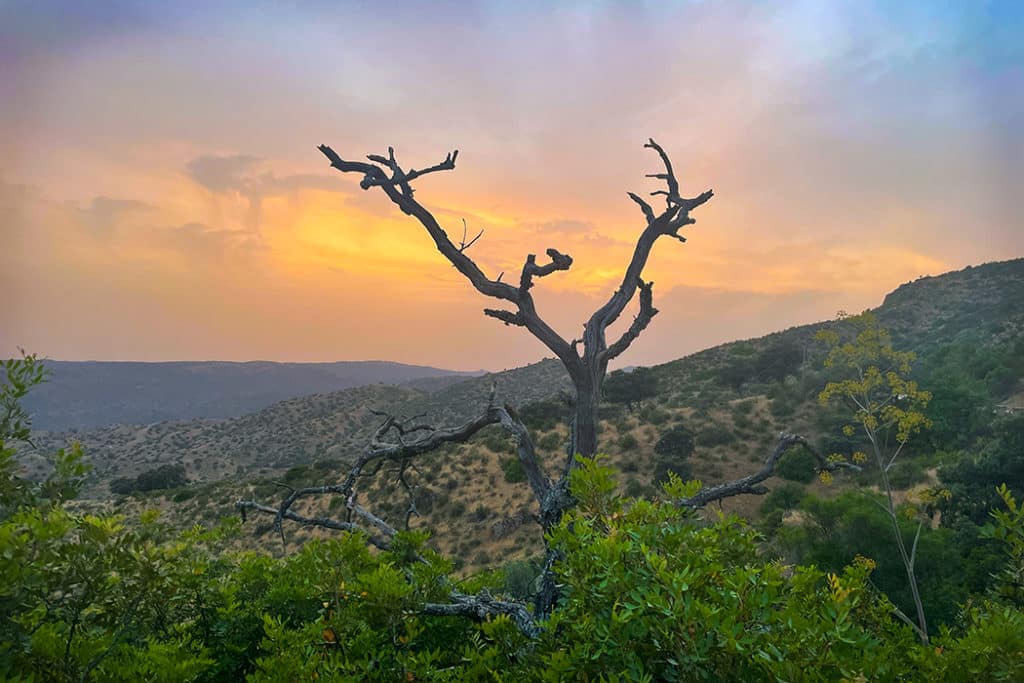
In the late afternoons, we often found the cubs alone, either snoozing in the shade or bouncing about. In the three weeks I watched the family, the cubs almost doubled in size and grew from fluffy round balls to lanky teenagers.
Jandula Reservoir
Since most of Sierra de Andujar Natural Park is privately owned, there isn’t that much to do in the park beyond standing on the side of La Lancha road, scanning the rocky valley.
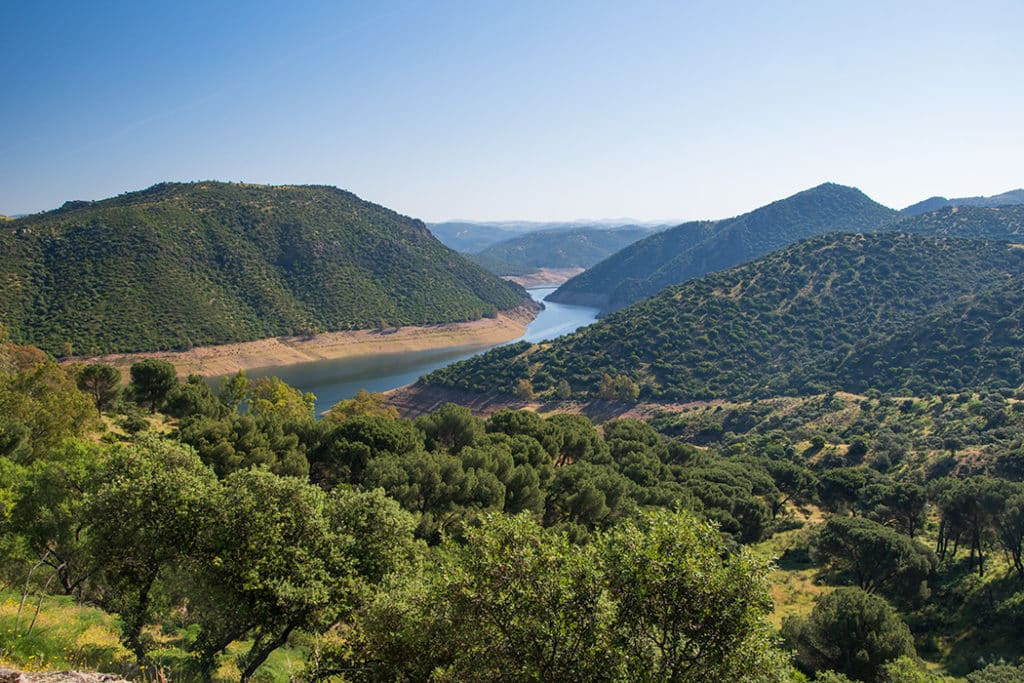
Further down the road, there is a publicly accessible area around Jandula Reservoir. The reservoir itself is quite scenic, and the dam is crowned by a very Moorish-looking tower.
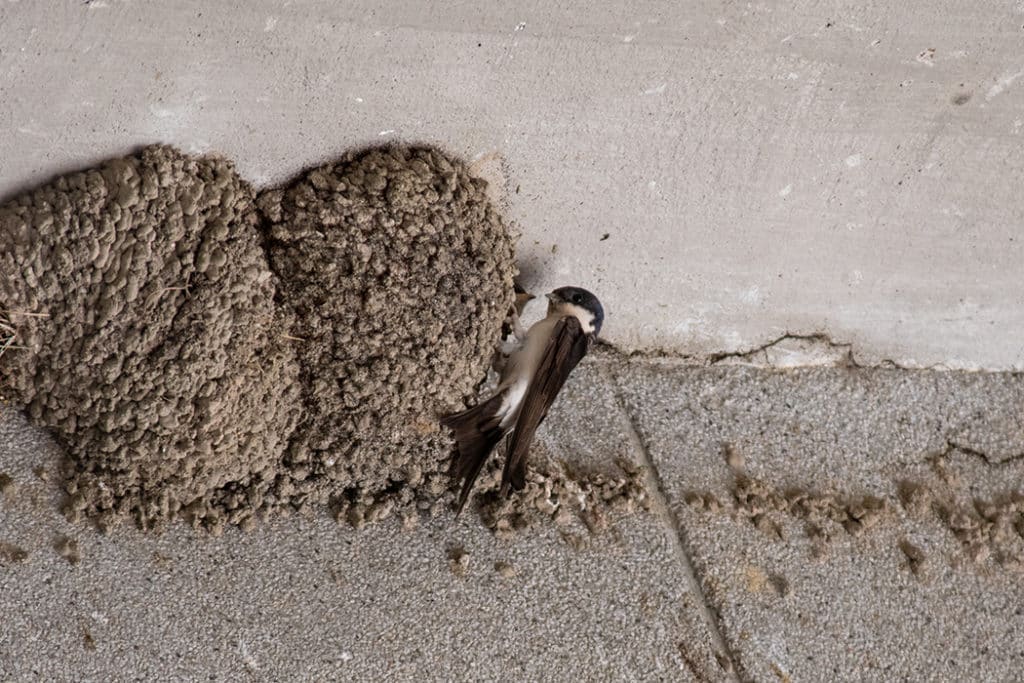
The House martins claimed the tower as their nesting ‘cave’ with dozens of their cup-shaped nests clinging to the stone walls. There were hundreds of martins darting in and out of the tower and flying above the dam.
Tip: Getting a Spanish sim card is a good idea if you want to use the bird ID app on your phone. I would be lost in the incredibly diverse bird world without my Merlin Bird ID.
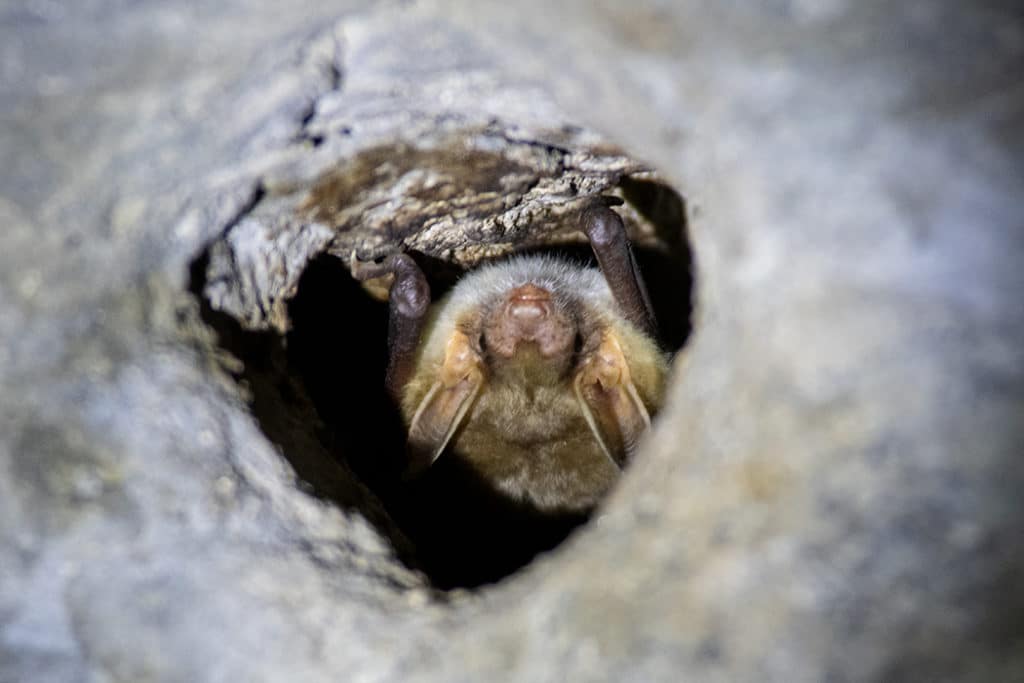
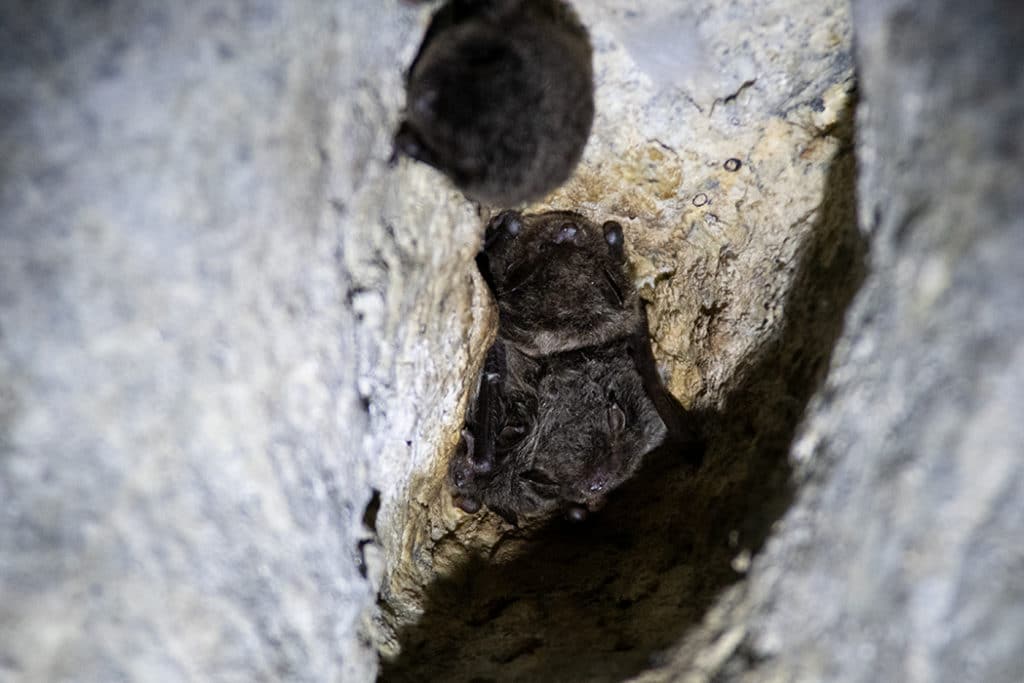
On the other side of the river, the road goes into the tunnel, which turned out to be home to three different species of microbats. Of course, given that I only visited the dam in the late morning, I likely missed many of the area’s wild inhabitants.
La Lancha Village
Just before the dam, there are some crumbling remnants of La Lancha village that housed dam construction workers in the 1920-1930s. The village, and even more so the dam itself, is the reason there is a (rarely) maintained road through the park at all.
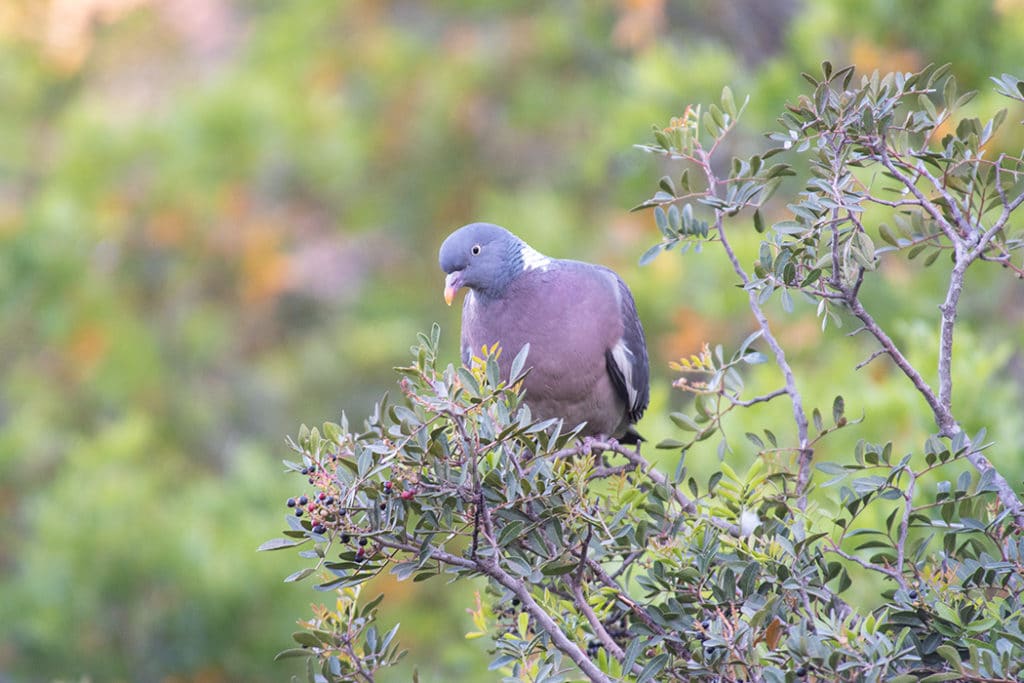
There isn’t much to it apart from the walled perimeter and some dilapidated buildings, but this spot has a particularly nice view of the reservoir.
It is also a good birdwatching spot, but earlier in the day. There is a small parking bay just opposite the village that makes for a good hiding spot for sneaking up on birds.
Other mammals in Sierra de Andujar
Sierra de Andujar is not all about the lynx, of course. But most other mammals you see here belong to the so-called “game species”, meaning it is legal to kill them for recreation. As I mentioned, the park is comprised mostly of hunting estates, so the majority of large mammals here are those that people come to hunt.
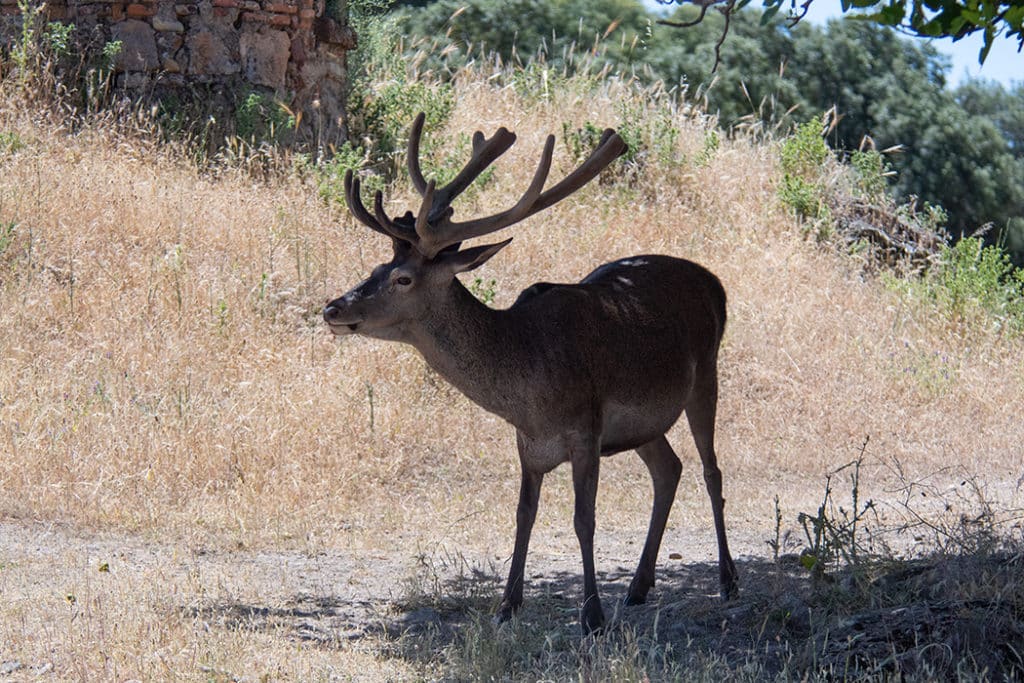
Red deer and Fallow deer are easy to see wandering across the road or browsing in the open areas. There are plenty of wild boars, but their harder to spot because they are smaller. Iberian ibex are occasionally seen on the rocky slopes while scanning for lynx. There are also European rabbits, lynx’s main prey.
Birds of Sierra de Andujar
Before Sierra de Andujar Natural Park became known as the go-to place for Iberian lynx watching, it was already a popular birdwatching destination in Spain. It is home to two highly endangered birds of prey: the Imperial Eagle and the Black Vulture. Both are regularly seen from the lynx-watching area on La Lancha road.
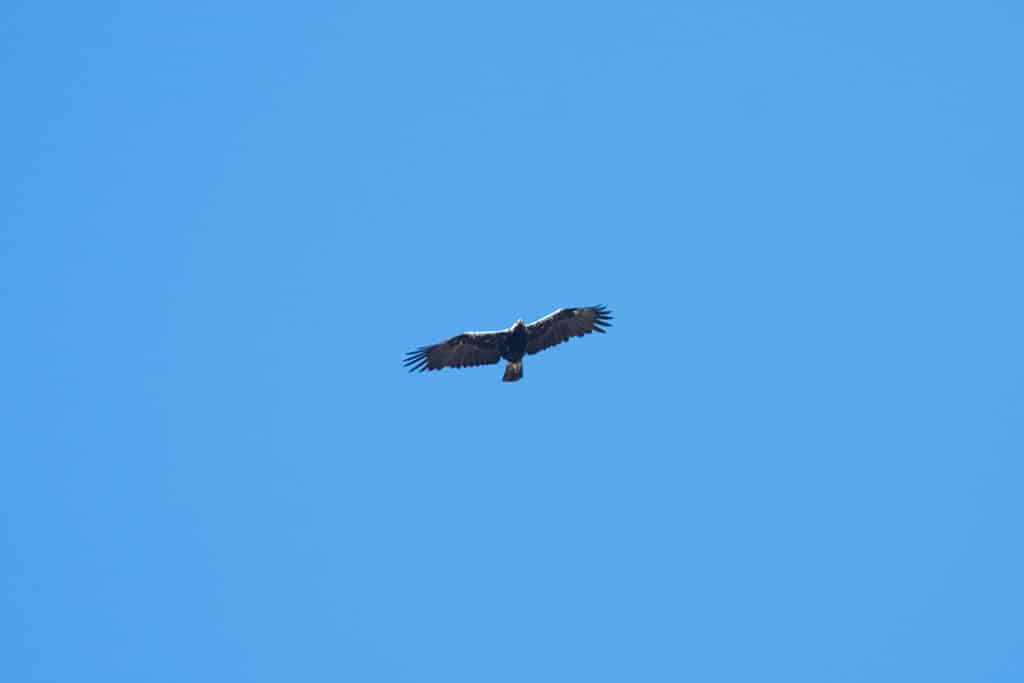
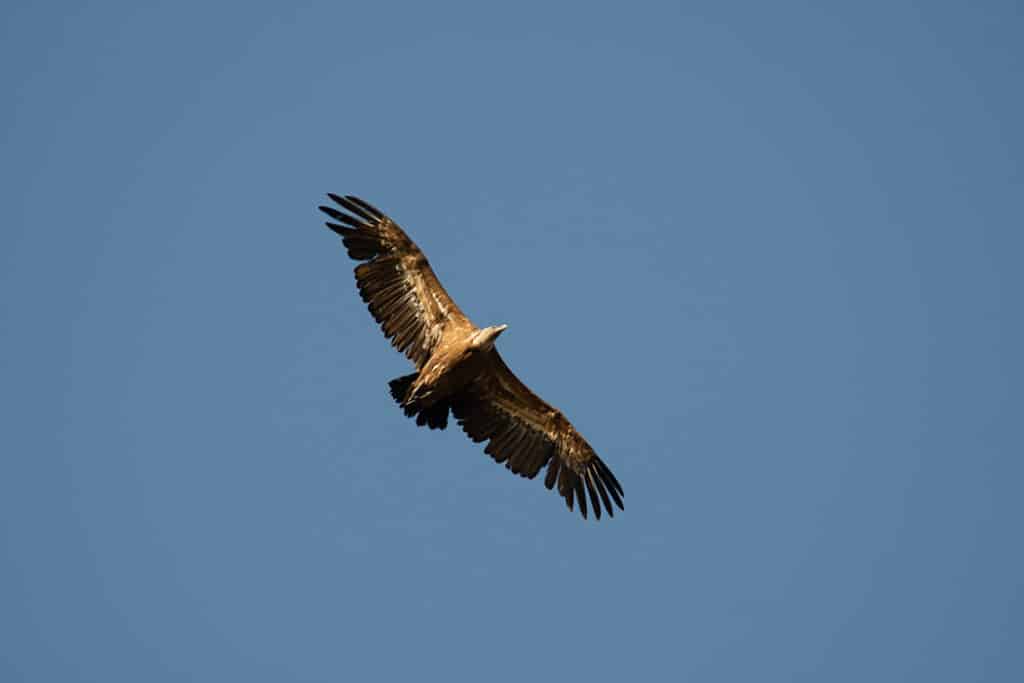
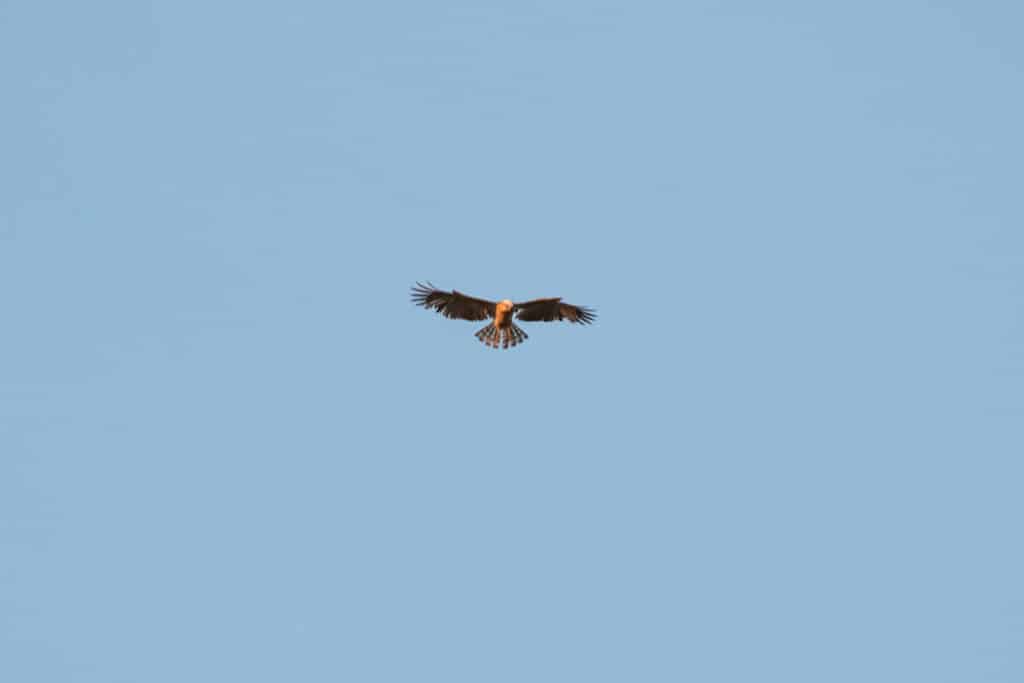
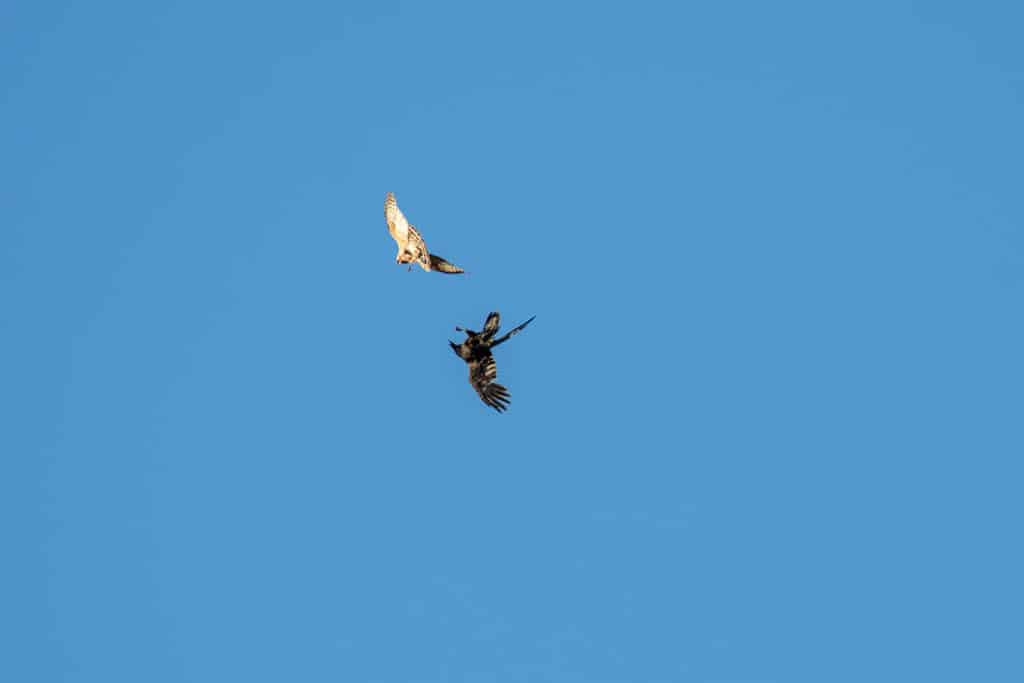
But much more common are the Griffon vultures – you’ll see them almost anywhere anytime and often in large numbers.
Little owls are fun birds to see. And to hear! They sound like meowing cats. I saw them most mornings perched on the wires over the valley. One also liked to roost on the rocks just behind the second last mirador on La Lancha road.
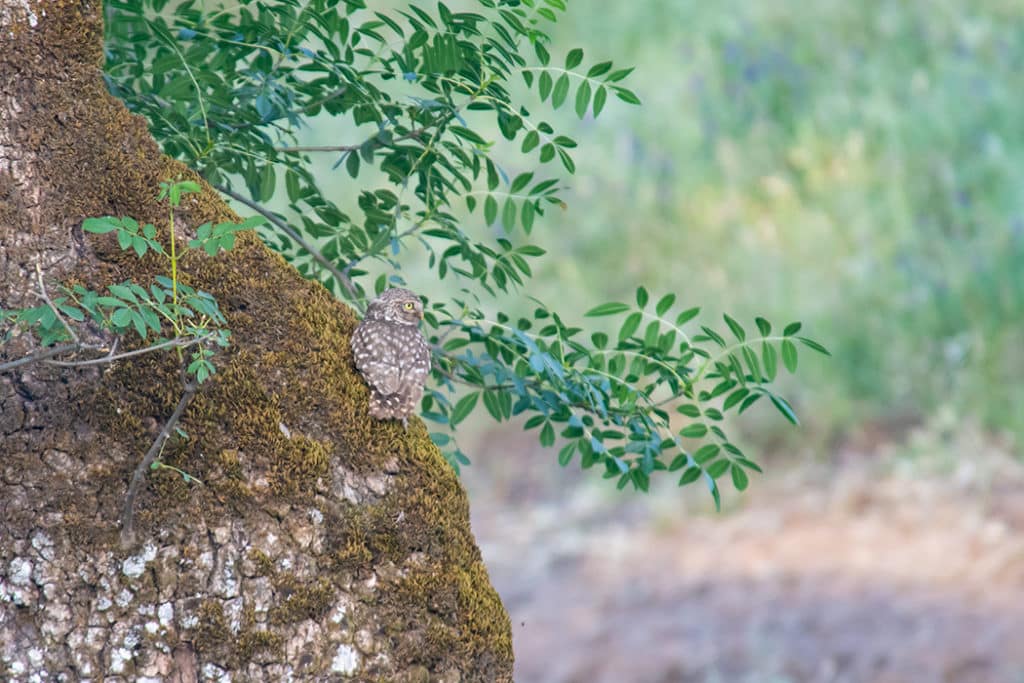
The bird that most birders get excited about is the Great spotted cuckoo. They are not as easy to spot, but if you spend enough time looking for the lynx, you are just as likely to spot the cuckoo.
In terms of endemic species, Iberian magpies and Green woodpeckers can be spotted without going on specialized birdwatching tours.
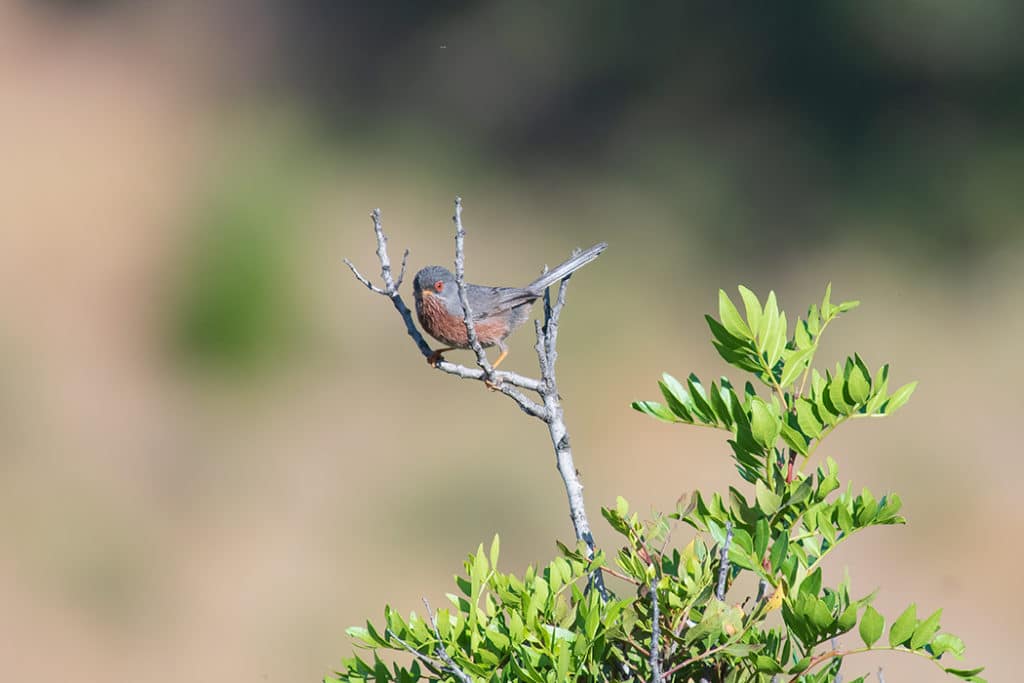
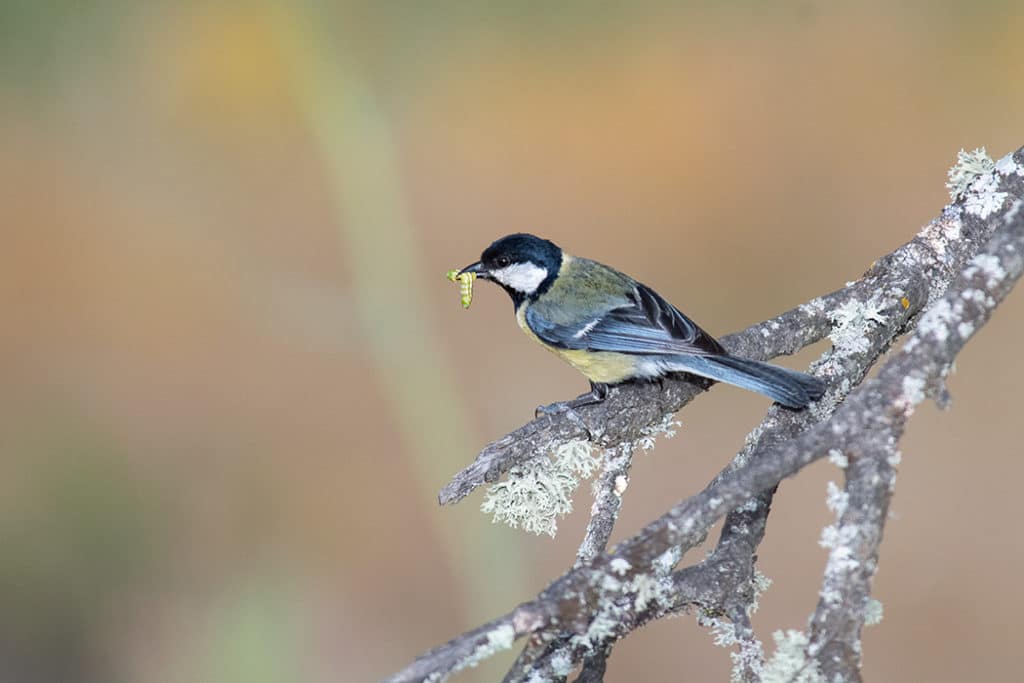
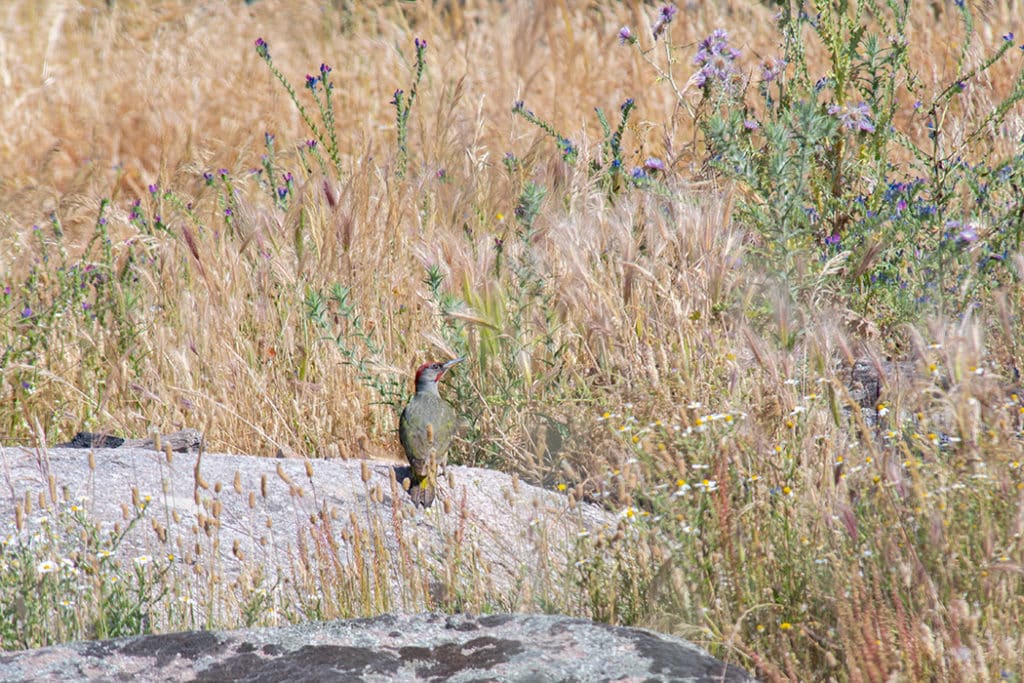
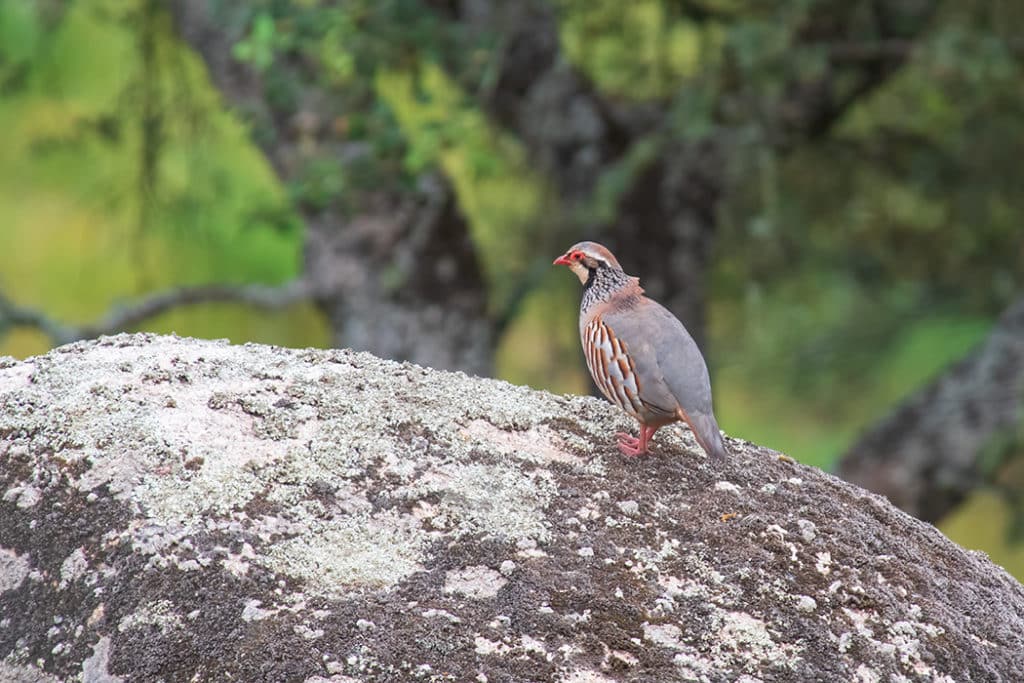
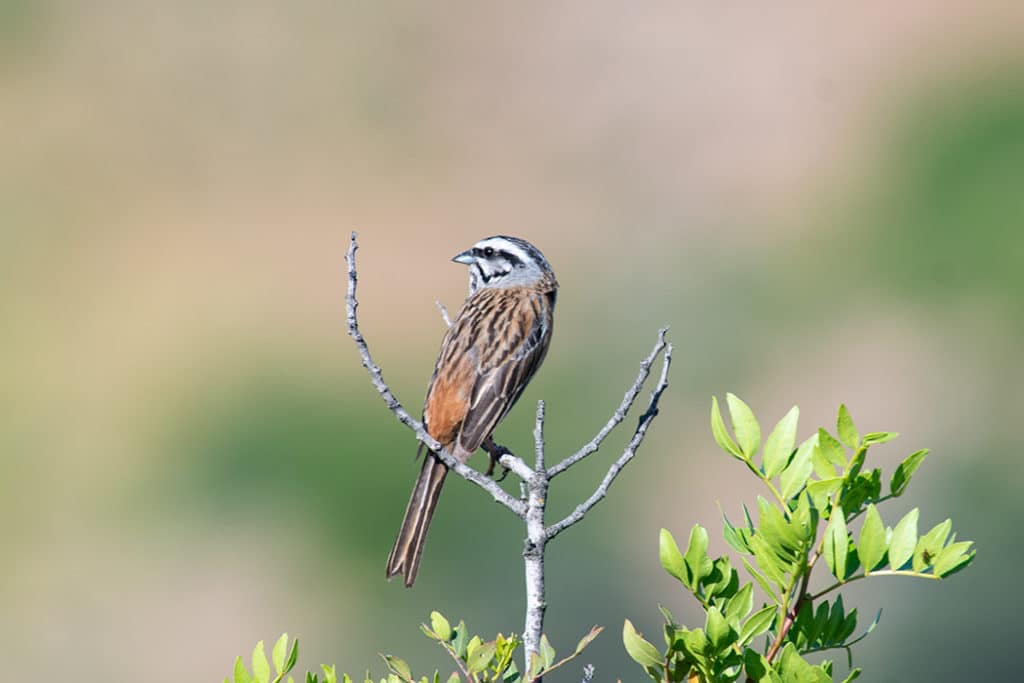
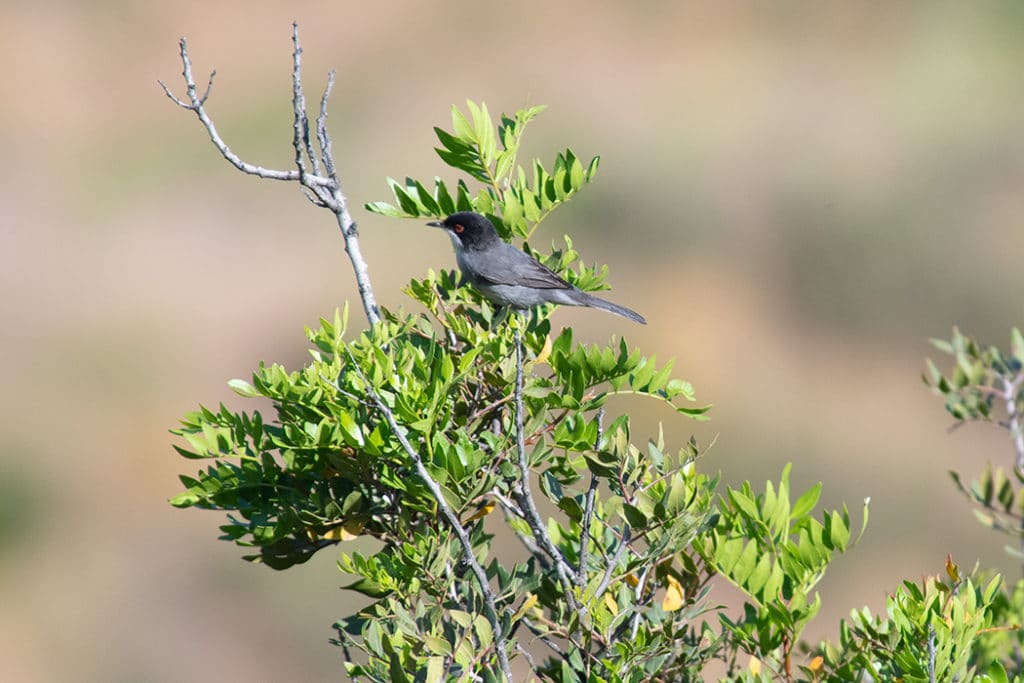
Other common birds I saw on La Lancha road are Black and white magpies, Hoopoes, Red-legged partridge, Common wood pigeon, Great tit, Rock bunting, Dartford-warbler, and Sardinian warbler.
Reptiles in Sierra de Andujar
The most famous reptile in Sierra de Andujar is the Ocellate lizard, endemic to southwestern Europe. I didn’t manage to spot this impressive-looking reptile but did see a few different skinks.
Our most interesting reptile sighting was a Lataste’s viper. This small but highly venomous guy took his time crossing the road which gave us plenty of opportunities for a good look
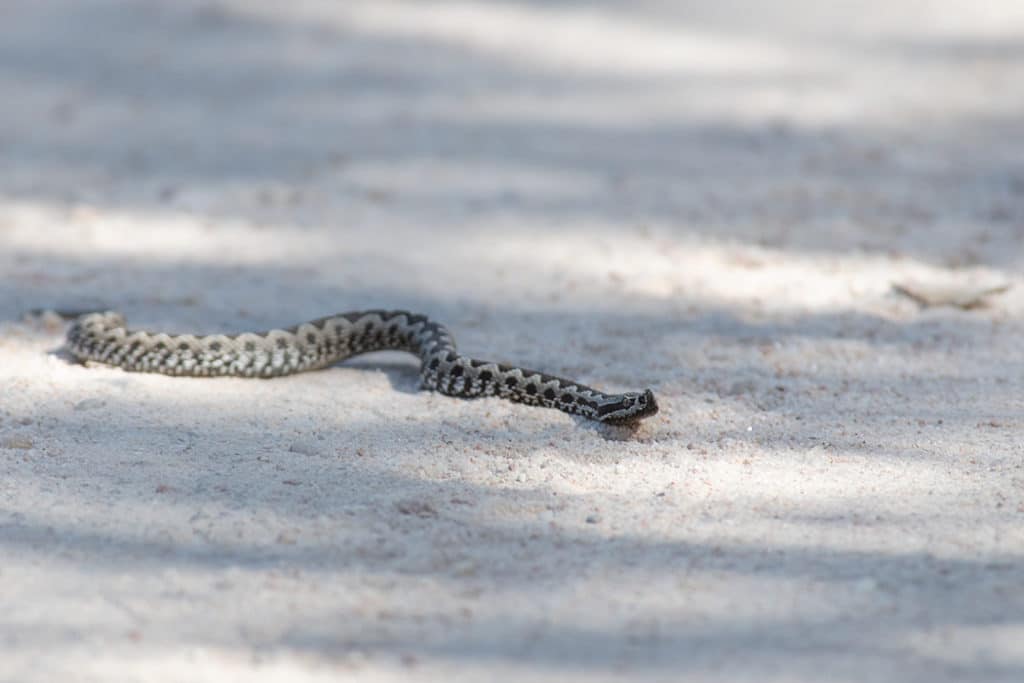
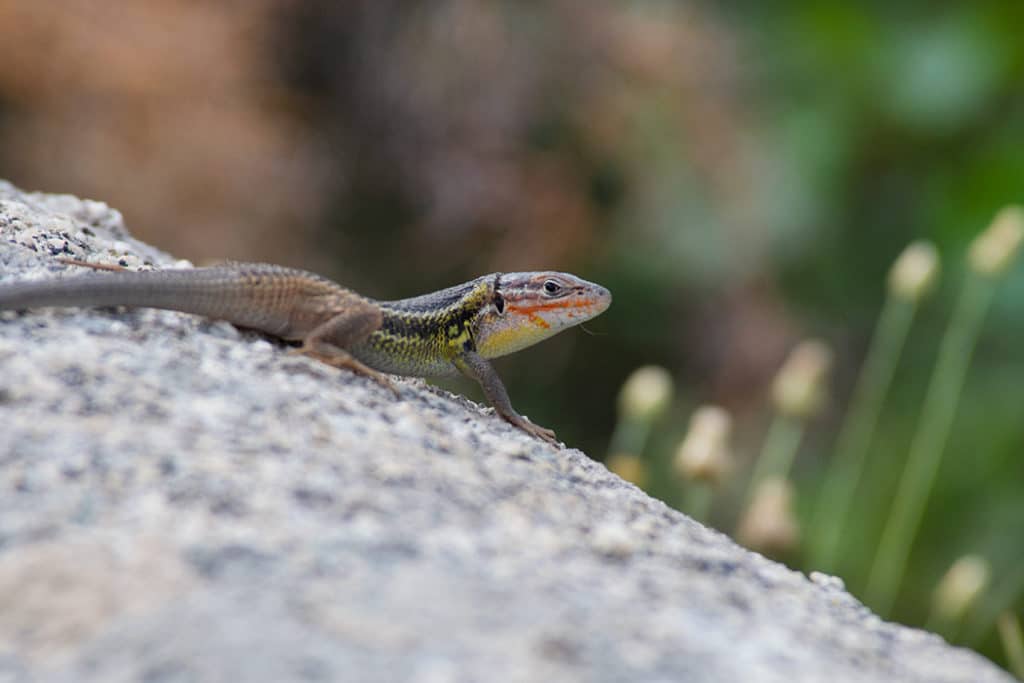
La Recta Recreational Area
Another publicly accessible area in Sierra de Andujar is the recreational area in Lugar Nuevo entered off JV 5001 road. To visit it, you just turn up at the front gate, and the security guard will let you in and accompany you in his own vehicle during your visit to the riverside area.
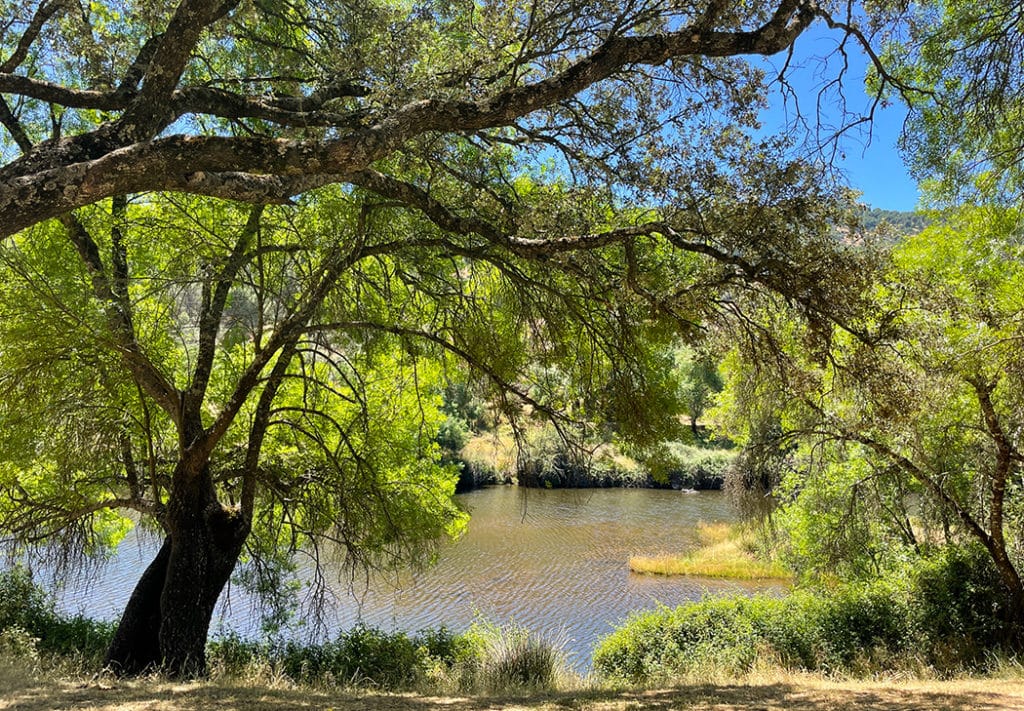
There isn’t much here apart from some picnic tables, and on weekends it does get crowded. But it’s a nice change of scenery from the dry valley to the riverine habitat.
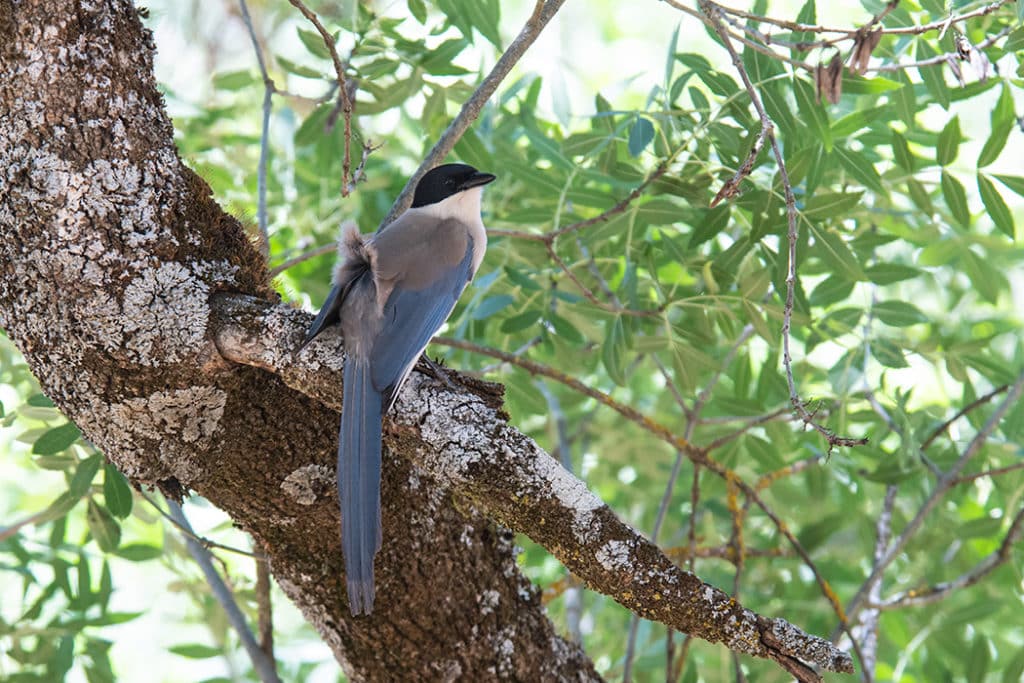
There are lots of turtles living in the river, and the Iberian magpies are quite tame here, so if you want to photograph them, this is the spot.
Observatorio Doña Rosa
Nearby, the Doña Rosa observation area used to be the prime Iberian lynx watching spot in Sierra de Andujar. But it is much harder to spot a lynx here because, unlike the sweeping view of the valley from La Lancha road, Doña Rosa is a forested area with limited visibility.
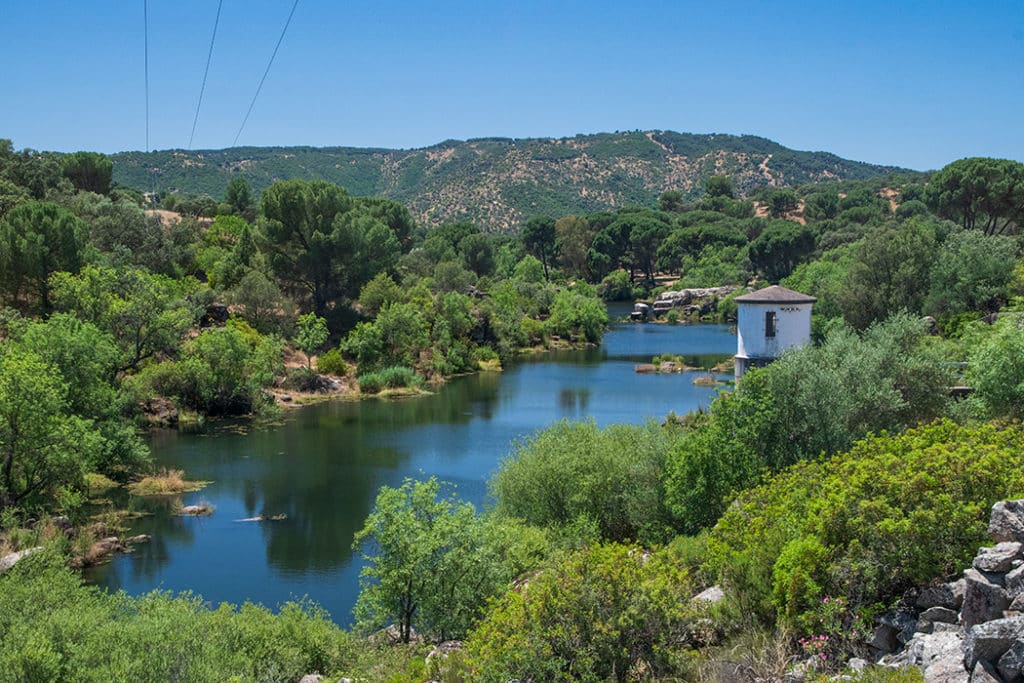
There is another dam here, smaller than Jandula but still quite picturesque. And the river is an excellent spot for the Eurasian otters. I haven’t seen them because I spent all my mornings watching Magarza’s family, but everyone who did go to Doña Rosa in the morning managed to see the otters.
Our Lady of Cabeza Church
The area’s claim to fame is the church of Our Lady of Cabeza (Virgen de la Cabeza). This church or sanctuary is the oldest pilgrimage site in Spain. Although in modern times, a pilgrimage is more of a party festival with lots of drinking than a religious experience.
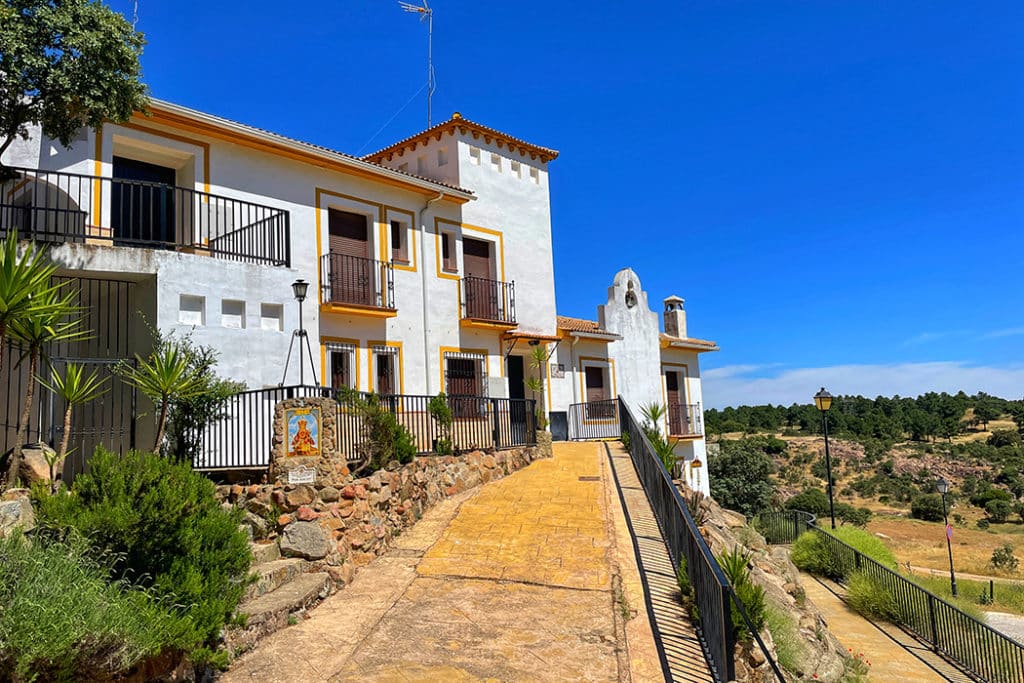
Still, in 2022, up to 500,000 people made their way to the sanctuary in the last week of April. Even the lady at the car rental counter in Cordoba had a story to tell about this sanctuary once she learned I was going to Andujar.
The history of Virgen de La Cabeza goes back to 1227, when the Virgin is said to have appeared to a shepherd from Granada and commanded him to go to the village and tell the people to build a shrine for her. The shepherd went to what is now Andujar, but no one believed him. So he returned to the mountains. When the Virgin appeared to him again, he complained that people didn’t believe him.
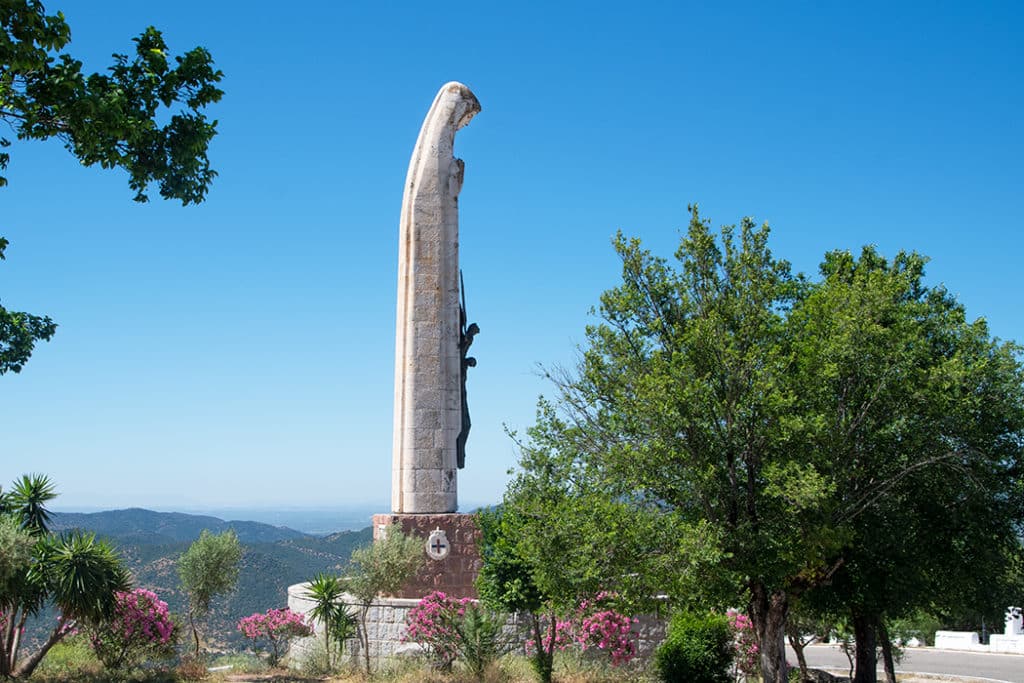
Not to be deterred, the Virgin healed the shepherd’s old injury and made his arm grow back. So he went to Andujar again, and this time, people believed him and built a church on top of the hill as instructed.
The original church was destroyed during the Civil War in the late 1930s. At the time, the Catholic Church supported the dictator General Franco, and just after the war, Guardia Civil (Franco’s police force) was gathered at the sanctuary to protect it from the republican forces. The Republicans decided to use the opportunity of having so many enemy soldiers gathered in the same place and bombed the sanctuary, killing everyone at the site and destroying the church.

The new church was built in the 70s. There is a plaque in front of the church that commemorates the fallen (nationalist) policemen. Many local people wonder why the government hasn’t removed this conspicuous nod to the dictator and his regime.
How to Visit Sierra de Andujar Natural Park
Sierra de Andujar Natural Park lies in the Andalusian countryside, 40 km from Andujar and 100 km from Cordoba. Some tour operators arrange trips to this area, including Naturoots, Iberian Lynxland and Birds and Lynx Ecotourism.
The rural community of Viñas de Peñallna on the edge of the park is a good base for visiting the park independently.
I stayed at the gorgeous Villa Matilde and made good friends with Mercedes and Roland. Their genuine hospitality made me feel like I was staying with my Andalusian relatives.
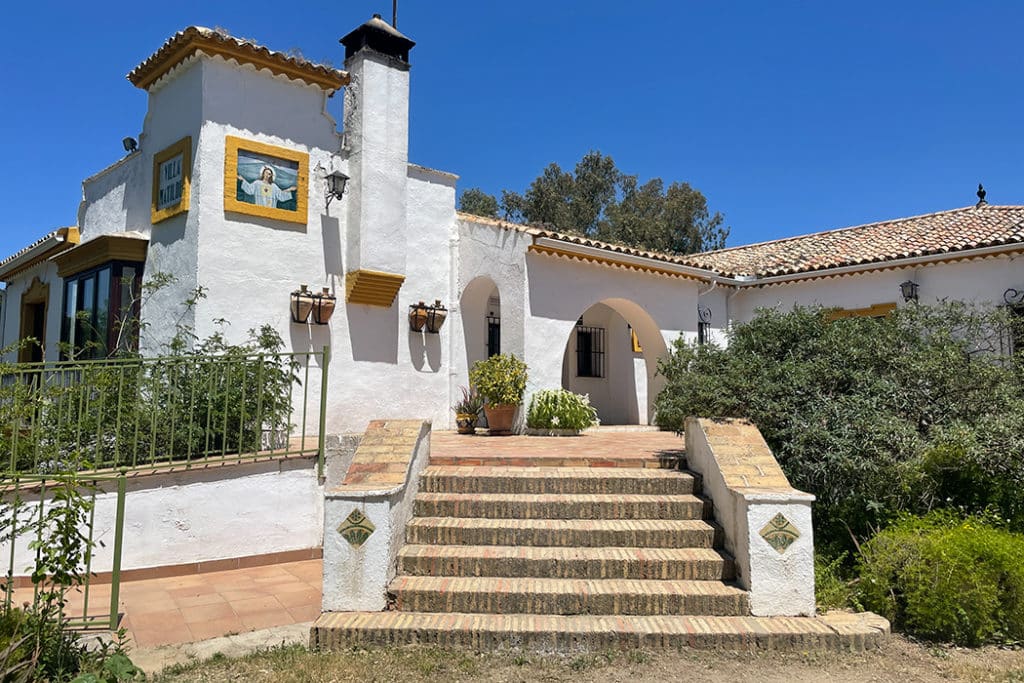
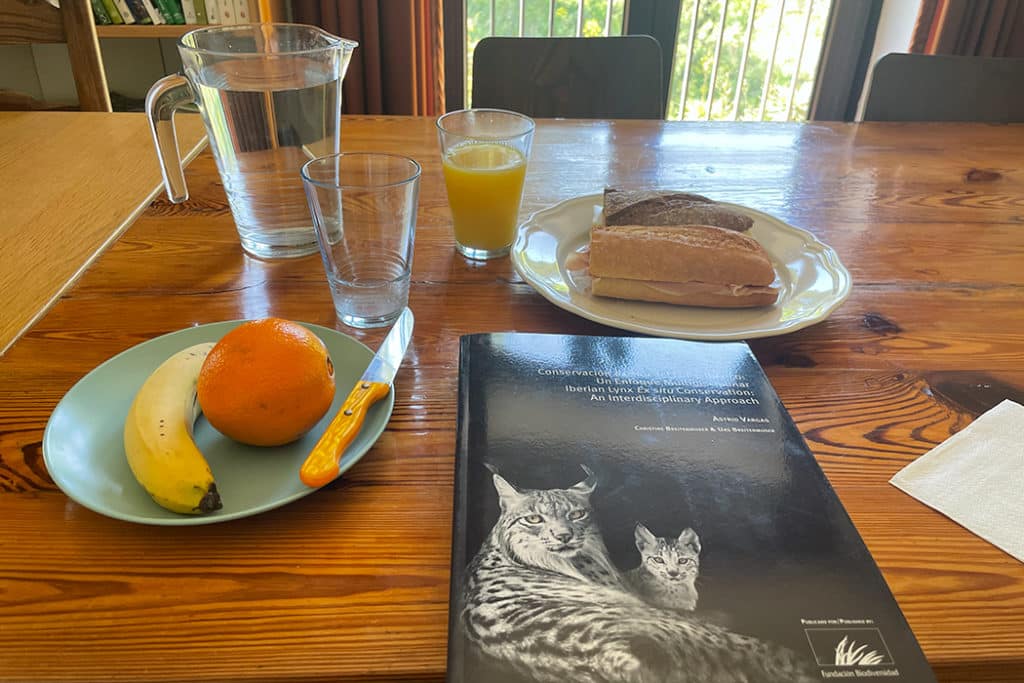
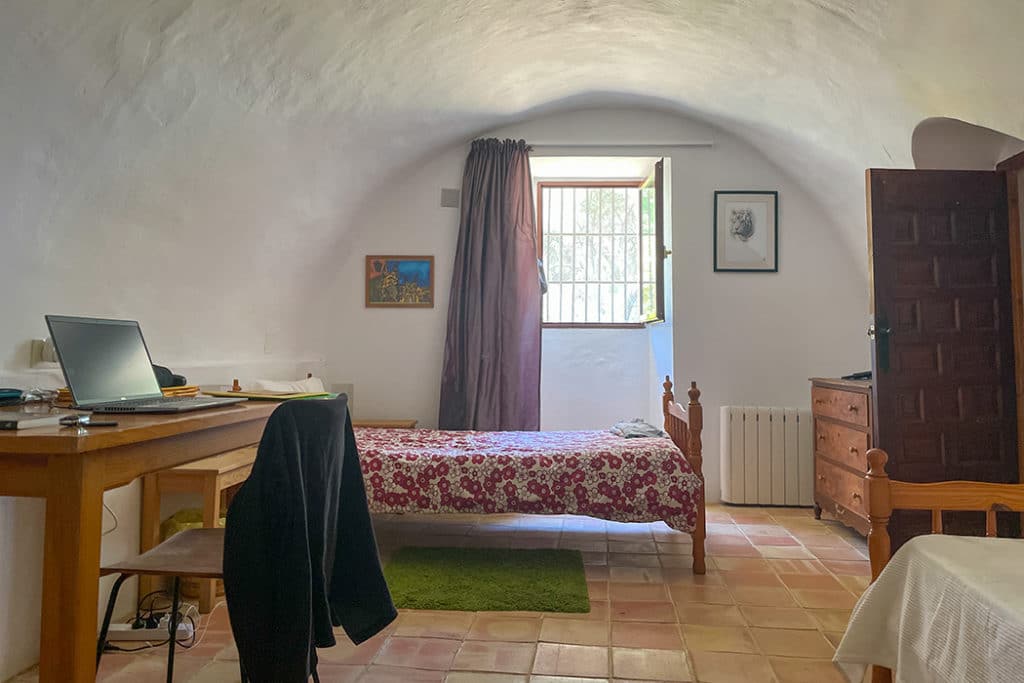
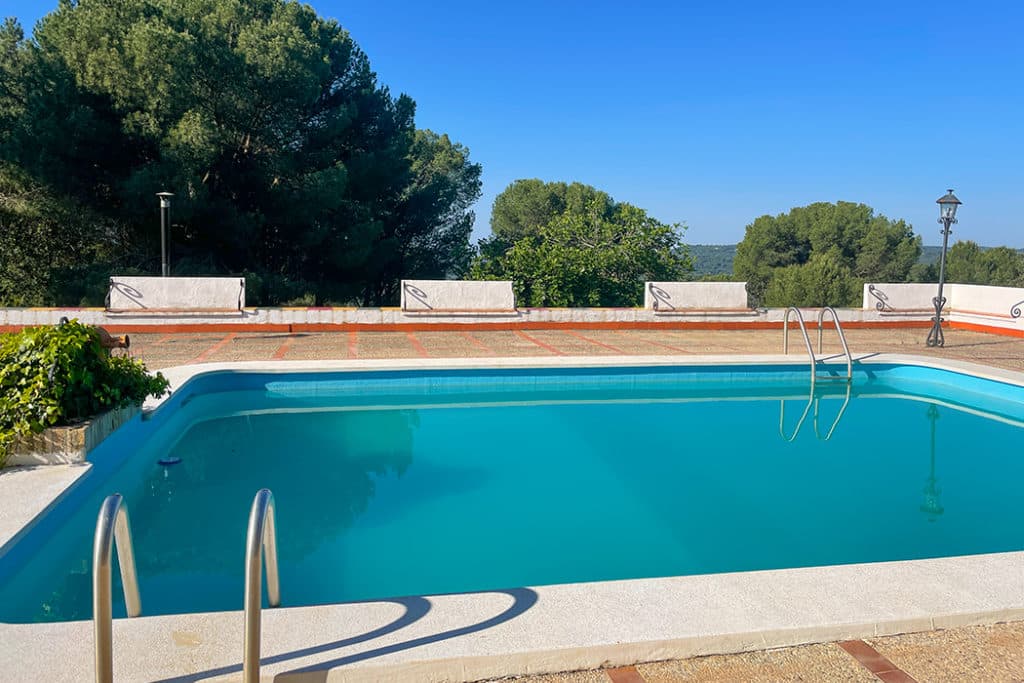
There is also the local pub that has now grown to become a tourist complex, Los Pinos. They offer accommodation and have a good restaurant, but don’t expect to be making your orders in English. They do have a lovely shop at the reception that sells all kinds of Iberian lynx paraphernalia.
Wherever you stay, follow JH 5002 road into the countryside and then turn left onto the La Lancha dirt road (JH 5004). It’s 7.4km from Villa Matilde to the turnoff. Then it’s another 6 km to the start of the lynx-watching area, but this road is so bad that it will take you a good 15-20 minutes to drive it.
Once you reach a series of wooden lookouts (or miradores), you have arrived. Drive slowly and see where the people are. This is probably where the lynx was last spotted.
If you are a keen photographer, book a hide with Naturoots – a local tour operator offering accommodation, photography hides and lynx-watching tours.
More on Exploring Spain
- 10 Ideas for Planning an Amazing Southern Spain Road Trip
- 26 Things to Do in Cordoba: Guide to Planning Cordoba itinerary
- Roman Cordoba Self-Guided Walk
- Guide to Visiting Cordoba Mezquita, When to Visit and What to See
- Discover Moorish Cordoba in 16 Monuments
- 15 Picturesque Walled Cities in Spain – Beyond Game of Thrones
- 16 Best Things to Do in Avila – Spain’s Amazing Medieval Walled Town
- 17 Fabulous Weekend Breaks in Spain: Must-See Destinations and Hidden Gems
- Sacromonte Caves: The Best-Kept Secret in Granada
- Discover Moorish Granada in One Day on This Self-Guided Walk

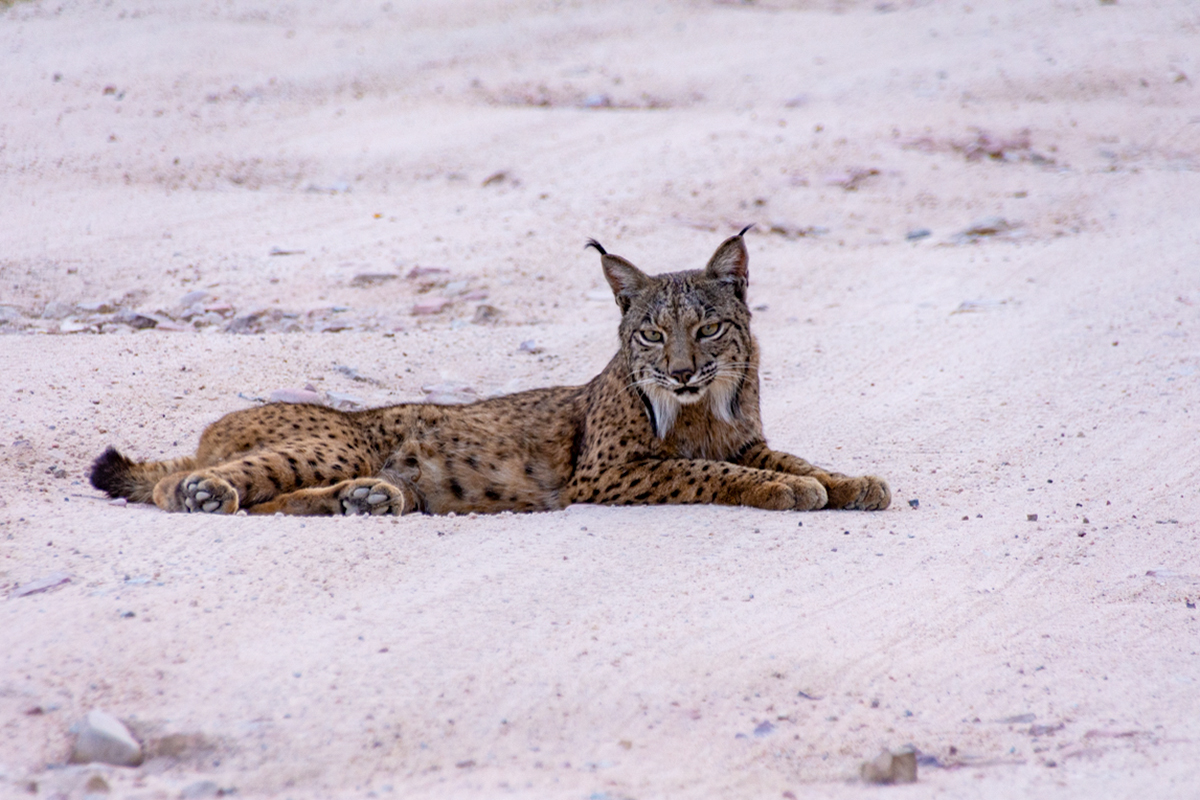

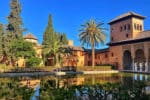
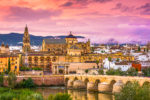
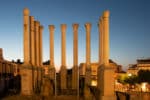

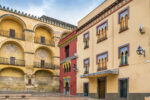

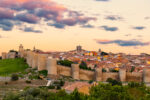

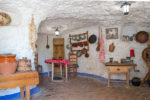
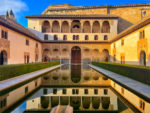
Hi Margarita,
Thank you very much for your very interesting and informative article. I found it very helpful in planning my trip to Andujar Natural Park.
I hope to visit it this year to see and photograph wildlife there. Hopefully, I will be lucky enough to meet a lynx, it will be a dream come true to get at least a couple of photos of that magnificent animal.
Do you mind to share when did you visit the park and what time of the year will be the best to meet mother lynx with her kits? It will be my first wildlife photography tour, so I’m trying to prepare myself as well as I can.
Many thanks in advance for your reply.
Regards,
Elena
Hi Elena,
I visited in late May – early June and I think its the best time to see the cubs in Sierra de Andujar (providing the resident female has the cubs this year). In April i think the cubs are still too small to leave the den and from mid-june onwards it becomes unbearably hot. And as usual, early morning and late afternoon are best. The middle of the day is too hot to stick around anyway.
Best of luck on your adventure!